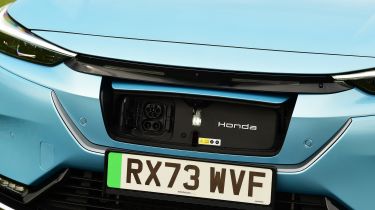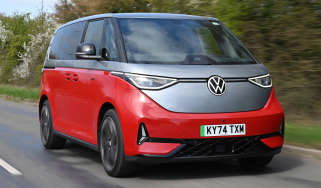Honda e:NY1 - Range, charging & running costs
Honda’s EV offers decent rather than spectacular range and charging speeds, while its residual values are strong.

All Honda e:Ny1s have the same powertrain built around a 68.8kWh battery with a 62kWh usable capacity. The charging port is concealed behind the big panel carrying the Honda badge in the car’s nose, so you can easily park head-on or side-on to chargers. You can see the car’s charge status at a glance – either by looking at the app or the clever pulsing lights above the car’s charge port.
| Model | Battery size | Range | Insurance group |
| Honda e:Ny1 Advance | 62kWh | 256 miles | 39E |
| Honda e:Ny1 Elegance | 62kWh | 256 miles | 40E |
Electric range, battery life and charge time
The maximum charging speed for the e:Ny1 is 78kW, which is similar to key rivals but lower than the Volkswagen ID.4, which can charge at up to 135kW. This means that a 10 to 80 per cent charge from a public rapid charger will take 45 minutes. There’s also an 11kW AC charger on board to facilitate charging from a typical home wall box charger, where you’re looking at 8 to 9 hours for a full charge.
During our extensive testing of the Honda e:Ny1, we found the car to be admirably efficient in good conditions. The trip computer showed 4.1 miles per kWh during our initial drive, which puts the car within two miles of its official 256-mile range – even over a varied test route. This was in the car’s Eco mode, which optimises the electrical systems and powertrain to maximise efficiency and makes for a more relaxing drive by taking the edge off the power delivery.
Used - available now

2025 SEAT
Arona
25,255 milesManualPetrol1.0L
Cash £12,898
2023 Mercedes
GLC Coupe
36,607 milesAutomaticDiesel2.0L
Cash £28,490
2023 Kia
Sportage
9,053 milesManualPetrol1.6L
Cash £20,814
2023 Kia
Sportage
23,005 milesAutomaticPetrol1.6L
Cash £24,881However, our second drive of the e:Ny1 was in very cold weather, and we could only average 2.4m/kWh, equating to a range of 165 miles. Activating the heater also greatly impacted the predicted range, cutting an indicated 181 miles to just 134 miles. The e:Ny1 does not have a heat pump, making it particularly susceptible to range drops in cold weather. By comparison, on the same cold weather test, a heat pump-equipped Hyundai Kona Electric only saw a 5-mile indicated range drop when the heater was turned on.
Tax
The Honda e:Ny1 presently isn’t charged a yearly VED rate because it is a zero-emissions vehicle, and it also can be driven into the congestion charge zone for free – at least until 2025.
Company car drivers will pay the lowest 2% rate of Benefit in Kind company car tax, but from 2025, this will increase 1% per year until 2028. However, it’s still very affordable compared to petrol and diesel models for business users.
Our Car Tax Checker tool lets you check your tax status and renewal date in seconds. Check your VED car tax now...
Insurance groups
The Honda eNy1 is in insurance groups 39 to 40. That’s 39E for the entry-level Elegance models and 40E for the Advance trim level. The E means the cars ‘exceed’ the car security requirement. Compare the insurance groups to those of rival models, and the Volvo EX30 will be slightly cheaper to insure, sitting in groups 35 to 37 for the Single Motor models. The Hyundai Kona Electric with the 65kWh battery sits in groups 31 to 33.
Depreciation
Our car market data experts predict that the Honda e:Ny1 will hold onto around 56 per cent of its value after three years and 36,000 miles. That’s a fairly good depreciation performance when you look at the Volvo EX30 (51 to 54 per cent), the Hyundai Kona (39 to 51 per cent) and the Volkswagen ID.4 (56 per cent).
To get an accurate valuation of a specific model, check out our valuation tool...










